Shevlin Sebastian's Blog, page 88
July 12, 2016
Captain Radhika Menon wins Bravery Award
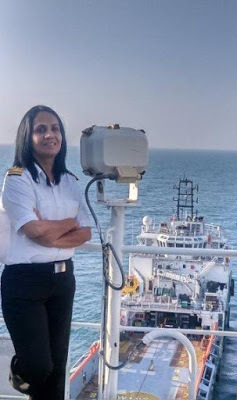
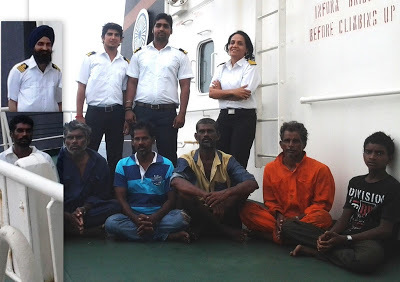 By Shevlin Sebastian
By Shevlin SebastianPhotos: Captain Radhika; with the crew and the rescued fishermen
Radhika Menon, the captain of the oil tanker, 'Sampurna Swarajya', and the first Merchant Navy woman captain, is to receive the 2016 International Maritime Organisation Award for Exceptional Bravery at Sea. This is for her role in the rescue of seven fishermen from a sinking fishing boat off the coast of Orissa. She is also the first woman to win this award. It will be presented to Radhika at a function of the IMO at London on November 21.
“Captain Menon displayed great determination and courage in leading the difficult rescue operation in the Bay of Bengal in June last year,” says a member of the IMO.
A thrilled Radhika says, from her ship at Mumbai, “The news has not yet sunk in. To be honest, I was not trying to win any award when I initiated the rescue operation. Instead, I considered it my duty. But, yes, the recognition from the IMO is memorable and I am humbled and honoured.”
Incidentally, this is her second award. On April 5, National Maritime Day, the National Maritime Day Celebration Committee of India conferred the 'Seafarers Gallantry Award' on Radhika.
The rescue mission took place at noon, on June 22, 2015. Second officer Manoj Chauhan noticed a boat two-and-a-half kms away, off the coast of Gopalpur, Orissa. Owing to a deep depression there were fierce winds and rains. The wind speed was 60 to 70 knots, while the waves rose to a height of 25-27 feet. As a result, the boat was being tossed up and down.
Manoj informed Radhika. “When I looked through my binoculars, the men were waving their shirts and asking for help,” says Radhika, who is from Kodungallur. Radhika immediately ordered a rescue operation.
Because of the turbulent sea, it took three attempts before all seven were rescued. The fishermen, who ranged in age from the 15-year old Perla Mahesh to Narasimha Murthy, 50, were in bad shape. They were weak, starving and frightened. The food and water had been washed away. They survived by sucking on ice cubes from the cold storage, which is used for preserving the fish.
(The New Indian Express, Kerala edition)
Published on July 12, 2016 01:35
July 6, 2016
Tips From Prem Nazir
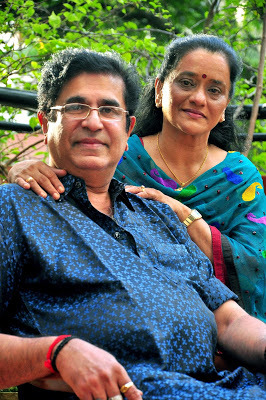
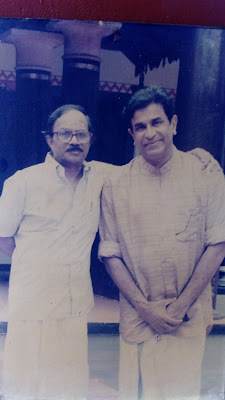 COLUMN: LOCATION DIARY Captain Raju talks about his experiences in the films, 'Raktam', 'Aana' and Oru Vadakkan Veeragatha'
COLUMN: LOCATION DIARY Captain Raju talks about his experiences in the films, 'Raktam', 'Aana' and Oru Vadakkan Veeragatha'Photos: Capt. Raju with his wife Premila. Photo by TP Sooraj. MT Vasudevan Nair (left) with Capt. Raju By Shevlin Sebastian In the film, ‘Raktam’ (1981), Capt. Raju had a fight sequence with Madhu at the Rama Varma club at Kochi. The crew had placed small sheets of wood (the pattika) of an old house on the floor. As Madhu hit Capt. Raju, with a shovel, the latter fell on the wood.
As the captain started running, he came in front of a tall tree which had a long creeper hanging from it. “Chandrakumar Sir shouted at me to grab the creeper and climb up,” says Capt. Raju. “Since I had done rock climbing during my military training, I had strong biceps and triceps. So I went up swiftly and reached a height of 40 feet.”
Aringodar stopped drinking, threw the coconut behind him, and said, “There is a lack of knowledge on your part. That is all that I have to say.”
(The New Indian Express, Kochi, Thiruvananthapuram and Kozhikode)
Published on July 06, 2016 21:56
June 29, 2016
Playing A Soldier
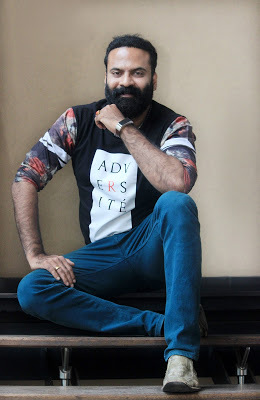 COLUMN: LOCATION DIARY
COLUMN: LOCATION DIARY Tini Tom speaks about his experiences in the films, 'Pattalam', 'Indian Rupee' as well as 'Pranchiyettan and the Saint'
Photo by Melton Anthony
By Shevlin Sebastian
Director Lal Jose had seen Tini Tom on mimicry shows and selected him for the Mammooty starrer 'Pattalam' (2003). On the set, Lal Jose noticed Tini's height and decided to give him the role of a soldier, along with [actor] Joju George. After a while, 400 real-life soldiers arrived.
As they waited on the sets, a black Mitsubishi Lancer came up. Out stepped Major Ravi, who had yet to start his career as a Mollywood director. He wore black sunglasses and a black jacket. The major lit a cigarette and shouted, “Attention. We will do a march past.”
So, Tini and Joju took their places among the soldiers. “It was only when we started marching that we realised how difficult it is to do it,” says Tini. “Because of us, the soldiers kept banging into each other.”
Major Ravi saw Tini, and said, “I know you. Which battalion do you belong to?”
Tini said, “Sir, I am from Kochi.”
A puzzled Major Ravi said, “There is no battalion in Kochi.”
Tini said, “I belong to a troupe.”
He said, “Which troop? And you took part in which war?”
Finally Tini said, “The biggest problem is that a few letters have been changed. I am from the mimicry and not the military.”
Finally, Major Ravi understood. A smiling Tini says, “This was my first experience on a film set.”
Tini's first proper role was in 'Pranchiyettan and the Saint' (2010), where he played a Mercedes Benz driver, called Subramaniam, who drove Mammooty around at the location in Thrissur.
But Tini's role was brief. After his work was over, he would drive the Mercedes Benz to the hotel where he was staying. One day, at the reception, he overheard one employee telling another, “This is the magic of cinema. One day you arrive in an Indica and the next day you can afford a Mercedes Benz.”
Meanwhile, in 'Indian Rupee' (2011), Tini played a real estate agent called Hameed. The hero, as well as the producer, was Prithviraj. In the initial days, at Kozhikode, there was a shoot, which involved fish. However, this did not appear in the final cut.
These were expensive pomfret, costing Rs 2500. On the first day, because of rains, the shoot was cancelled. This happened on the next three days. So, Tini told Prithviraj, “You are spending so much of money on the fish. Maybe you could provide it for our meals.”
A smiling Prithviraj said, “When you have dinner tonight, note the taste of the fish. It is yesterday's fish.”
That was when Tini realised Prithviraj was a good producer. “He had not wasted the fish,” says Tini. “Prithviraj had ensured that the crew ate it on all the days.”
On the set, Tini befriended the veteran actor Thilakan, who died in 2012. “Thilakan Sir would give me a lot of advice,” says Tini. “One day, he told me that eating too much rice and halwa is not good.”
But during lunchtime, Tini noticed that Thilakan was having both without any problems. So he approached the veteran and said, “Sir, you told me to control the intake of rice and halva, otherwise the sugar levels will go up.”
Tilakan replied, “I can do anything I want. I am supposed to be a person who creates problems (at that time, Thilakan was having a tussle with the Association of Malayalam Movie Artistes). Everyone says I don't listen to anybody. But you can listen to me.”
(The New Indian Express, Kochi, Thiruvananthapuram and Kozhikode)
Published on June 29, 2016 04:39
June 28, 2016
Making A Mark
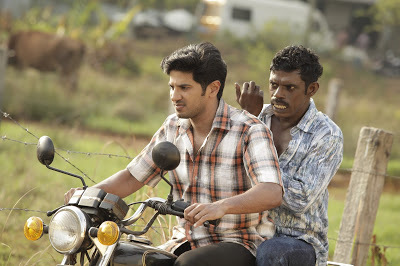
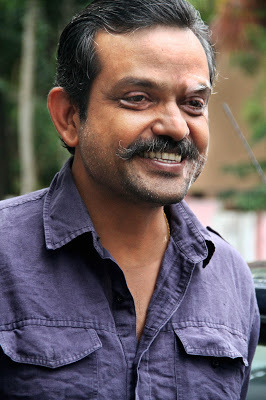 Rajeev Ravi's gritty and hard-hitting hit film, 'Kammattipaadam' marks the arrival of a major talent
Rajeev Ravi's gritty and hard-hitting hit film, 'Kammattipaadam' marks the arrival of a major talentPhotos: A scene from the film, 'Kammattipaadam'; director Rajeev Ravi. Photo by Mithun Vinod
By Shevlin Sebastian
Sound Designer Renganaath Ravee stepped out, after a morning show at the Inox Cinema, in Mumbai, recently, with a dazed look on his face. He had just watched the Mollywood hit, 'Kammattipaadam', directed by Rajeev Ravi.
“The direction was absolutely fantastic,” says Renganaath, who works in Mollywood and Bollywood. “I also liked the sounds, camera angles and the music. Lots of people were fans of [Mollywood directors] Bharathan and Padmarajan in the 1980s and wanted to emulate them. But, in this generation, it is Rajeev Ravi who is in the forefront. He is the new creative force in Mollywood.”
Another fan is Rajeev's Bollywood colleague Anurag Kashyap. The director tweeted: “Don’t miss ‘Kammattipaadam’. One of the best gangster/brotherhood films from India. Rajeev Ravi – the boss.”
The film is a gritty and unsparing look at the transformation of Kochi, post-liberalisation, in the 1990s. In fact, there did exist a huge expanse of land, called 'Kammattipaadam', in central Kochi, which consisted of paddy fields and mud tracks. But unscrupulous businessmen, taking the help of the youngsters of the Dalit community, got people forcibly evicted from lands, or paid them meagre sums, so that multi-storeyed buildings could come up. “In the last thirty years, there has been a massive 'development' in Kochi,” says Rajeev.
The film features leading star Dulquer Salman, apart from Vinayakan, Vinay Forrt, Shine Tom Chacko, Manikandan R. Achari, and debut heroine, Shaun Romy. But it was Manikandan who has stolen the show with his dynamic performance as a Dalit hoodlum called Balan.
“I did take a big risk by casting Manikandan,” says Rajeev. “But the theatre artists who brought him to me, Sujith Shanker and Vijay Kumar, said that he is a big talent. And he is.”
Asked why the film did well, Rajeev says, “The story of land-grabbing, for real-estate development, is something everybody is familiar with. So they felt an emotional connection with the film.”
However, for Rajeev, the inspiration for the film happened when one day, a few years ago, an image came unbidden to his mind. As an eight-year-old, he had just arrived, with his family, at Ernakulam South railway station. The family lived in Pathankot, because Rajeev's father worked in the Air Force. “One of my uncles picked me up and all I could see was an endless expanse of paddy fields,” says Rajeev. “It was beautiful. Now all that is gone.”
He passed all these memories to veteran scriptwriter P. Balachandran who has produced a taut and fast-moving script. This is Rajeev's third film. The earlier two were also received well: 'Annayum Rasoolum' and 'Njan Steve Lopez'.
Apart from this, he is one of Bollywood's leading cinematographers. Some of the films he has worked on, include 'Chandni Bar', 'Dev-D', 'Gangs of Wasseypur Part 1 and 2', 'Bombay Velvet' and 'Udta Punjab'. In 2010, he won the Filmfare Award for Best Cinematography for 'Dev D', as well as the national award for his wife, Geetu Mohandas' film, 'Liar's Dice'.
But it is as a director that Rajeev is expected to continue hitting the bull's eye. One who thinks so is Vinay Forrt, who has acted in 'Kammattipaadam': “If you want to make a good film about politics or human relationships, you should have some content inside you,” he says. “And Rajeev has it.”
(Sunday Magazine, The New Indian Express, South India and Delhi)
Published on June 28, 2016 00:59
June 22, 2016
Energetic And Vibrant
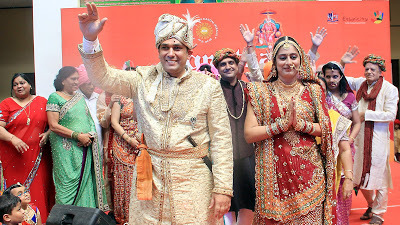
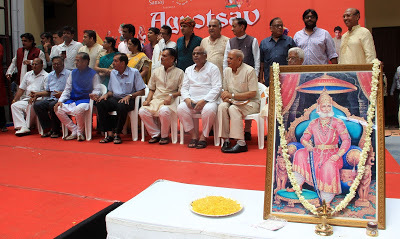 The one-day programme, on the Agrawal community, organised by 'Ethnicity--The Cochin Heritage Research Centre' of the English department of St. Albert's College, was a thumping success
The one-day programme, on the Agrawal community, organised by 'Ethnicity--The Cochin Heritage Research Centre' of the English department of St. Albert's College, was a thumping successPhotos by Melton Antony
By Shevlin Sebastian
“Who is the most famous Agrawal in the world?” says compere Akshay Agrawal.
“[Actor] Kajal Agrawal,” shout the students of St. Albert's College, Kochi.
Akshay burts out laughing and says, “No, it is Lakshmi Mittal [the London-based steel magnate].”
All of them had gathered in the college quadrangle to take part in 'Agrotsav', a one-day programme, which highlighted the culture, heritage, history and food of the Agrawal community.
The chief guest was Shabareesh Varma, the noted singer, who sent the youngsters into a frenzy of dancing, with his rendition of the hit song, 'Malare Ninne kanathirunal', from 'Premam'.
Soon, the lamp was lit in front of the photo of the community founder Maharaja Agrasen, who was born in 3125 BC. “This was during the Mahabarata period,” says Shyam Sundar Agarwal, chairman of the festival.
Thereafter, College Manager Fr. Antony Arackal inaugurated the snacks section at one side. The food included samosas, puris, kachori and different types of juices. Rajesh, the caterer, is from Rajashtan. “I have been living in Kochi for several years and provide food for all events of the Agrawal community,” he says.
The event was organised by 'Ethnicity--The Cochin Heritage Research Centre', of the Department of English. “Kochi is a melting pot,” says Nisha Thomji, the head of the department. “We felt it is necessary to study the various communities, who have settled in Kochi, like the Jews, the Gujaritis and the Konkanis. Last year, we had done programmes on the Goud Saraswat Brahmins as well as the Anglo-Indian community.” Incidentally, the centre was established in 2009 by Dr. Edward Edezhath, the former Associate Professor in English.
For this particular programme, it was noted writer KL Mohana Varma, who is also the chairman of the Centre, who came up with the idea. “I have been friends with Shyam Sundar for a long time,” he says. “It is a vibrant community and noted for its charitable works.”
The Agrawal community comprises only 150 families in Kochi, but they run around ten charitable institutions. “All of us are doing business,” says Rajkumar Agrawal. “But we also feel it important to give to society. Charity and donation are in our blood.”
Later, a seminar took place where speakers spoke about the history of the community as well as its culture and heritage. "This was arranged by the members of the Agrawal Yuva Mandal, especially office-bearers Akshay, Naren and Vinay Singhal," says Shyam Sundar. There were also dances and a fashion show.
The younger Akshay, expectedly, belongs to the second generation. “I grew up in Kochi and can speak Malayalam well,” he says. “At home, I eat both North as well as South Indian food. I am also an alumni of St. Albert's. Many of our community members have passed out from this college.”
As for Shyam Sundar, a member of the first generation, he came to Kochi in 1987. “I grew up in Salem, which is a dry place,” he says. “So Kerala, with its rains, is like heaven for me.” Despite many warnings from community members, he set up a flour mill in Kochi, went through labour problems, which almost closed down his unit, but managed to survive. Later, he built a steel factory and is now a prosperous businessman.
Shyam Sundar's wife, Durga, says, “I love Kochi for its greenery, cleanliness, and peace. We have assimilated easily into the liberal Kerala culture and have many Malayali friends. They are kind and friendly.”
Famous Agrawals
Sunil Mittal - Airtel
Naresh Goyal - Jet Airways
Rahul Bajaj - Bajaj
Gautham Singhania - Raymond
Subhash Chandra - Zee TV
(Published in The New Indian Express, Kochi and Thiruvananthapuram)
Published on June 22, 2016 22:46
June 21, 2016
Pushing A Rubber Piece Up The Nose
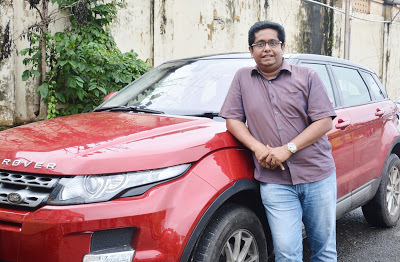
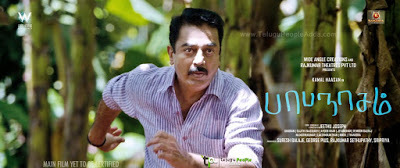 Photos: Jeethu Joseph by Ratheesh Sundaram; poster of Kamal Haasan in 'Papanasam' Then they both burst out laughing. (The New Indian Express, Kochi, Kozhikode and Thiruvananthapuram)
Photos: Jeethu Joseph by Ratheesh Sundaram; poster of Kamal Haasan in 'Papanasam' Then they both burst out laughing. (The New Indian Express, Kochi, Kozhikode and Thiruvananthapuram)
Published on June 21, 2016 22:07
June 20, 2016
Smoothly Gliding Along
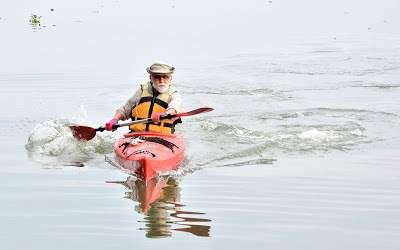
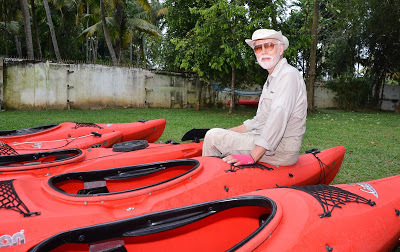 The German architect Karl Damschen is Kerala's leading conservation architect. But he has another passion: he is spreading the joys of kayaking among the people of Kochi
The German architect Karl Damschen is Kerala's leading conservation architect. But he has another passion: he is spreading the joys of kayaking among the people of KochiPhotos by Ratheesh Sundaram
By Shevlin Sebastian
From a distance, on the Vembanad lake, near Kochi, on a recent Sunday, German architect Karl Damschen saw that rain had begun to fall. He expected it to hit him at any moment. So, he stopped his kayak, quickly slid into his waterproof jacket, put on a hat with a wide brim, and zipped up the spray deck.
This is a flexible cover, which prevents water from entering the boat through the seating area. The ten kayaking members of the Global Sailing Club (GSC), at Panangad, Kochi, including Damschen's wife, Annelies, did the same.
The group began kayaking again. Soon, the rain hit them with force: thick, heavy drops, with streaks of lightning lighting up the dark sky. “It was so much fun,” says Damschen, 73. “Unlike in Europe, where the rain consists of cold water, this was warm and enjoyable.”
Thereafter, over a day, the team stroked their way to the town of Vaikom, 15 kms away, and returned to Kochi.
For the past two-and-a-half years, ever since the GSC was set up, Damschen has been propagating kayaking. “I have given a six-week training course to those who are interested,” he says. “As for the right technique, most beginners pull the paddle backwards, but in kayaking, you have to push forward, so that you can use the weight of your body. This is the method followed by the Eskimos.”
Thus far, there are 20 regulars. They include businessmen, industrialists, professionals and homemakers. And all of them go kayaking on the weekend. “It is only through kayaking that I could appreciate the beauty of Kerala,” says homemaker Anuja Asher. “We have gone to places where no car can go.”
Kayaking has a lot of benefits. “It is physically taxing, but enables you to keep fit,” says Annelies, 73. “And during a trip, you can observe nature at close quarters, especially when you move through the backwaters. It is also a smooth ride, unlike a car where you have to experience potholes, traffic jams and air pollution.”
The club, incidentally, has 11 kayaks. And they have all been imported, from the Prijon Kayak Company in Rosenheim, Germany, which is known the world over for making the best kayaks. The length of a single kayak is 16 feet, and its width is two feet. And it weighs only 24 kgs.
Damschen fell in love with kayaking as a child growing up in the town of Gelsenkirchen in North Germany. One day, when he was ten years old, while walking, with his grandfather, Johann, from a bridge he could see kayaks on a river. “I immediately became fascinated,” says Damschen. “But my grandfather told me that I had to be 16 years of age before I could learn it.”
So, when he reached that age, Damschen joined the Gelsenkirchen Kanu Club. Thereafter, for the next 12 years, he did kayaking in Europe, totalling a distance of 10,000 kms. “The kayaks, called Faltboot, could be folded up and taken around like a rucksack,” says Damschen.
However, in 1977, Damschen made a car trip, with Annelies, from Switzerland where he lived, to Kerala and Sri Lanka. They fell in love with Kerala. In 1981, the couple stayed in Thiruvananthapuram and spent six months there and six months in Switzerland. This went on for a few years. But, in 1996, Damschen settled in Kochi, where he has made a name as a restoration architect.
His future plans include teaching youngsters the joy of kayaking. “It is far more beneficial rather than spending time in malls, which is what most youths do these days,” he says, with a smile.
(The New Indian Express, Kochi and Thiruvananthapuram)
Published on June 20, 2016 22:37
June 19, 2016
A Kaleidoscopic View
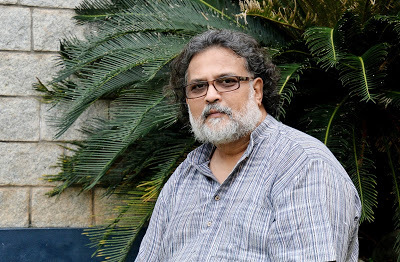 Tushar Gandhi, the great-grandson of Mahatma Gandhi talks about his childhood and the state of the country, while on a recent visit to Kochi
Tushar Gandhi, the great-grandson of Mahatma Gandhi talks about his childhood and the state of the country, while on a recent visit to Kochi Photo by Ratheesh Sundaram
By Shevlin Sebastian
When Tushar Gandhi steps into a hall at the Museum of Kerala History for a lecture on Gandhi, organised by the Friends of Tibet, at Kochi, on a recent Sunday, people swarm towards him.
That is the impact of being the great-grandson of Mahatma Gandhi. What surprises is his size and girth. And he touches upon this, in his speech, when he recounted an experience in a school at Chennai. “When the teacher introduced me, one Class 6 girl stood up and said, ‘Miss, he cannot be Gandhiji’s great-grandson. I think he is a wrestler’.”The man himself has a touch of humility. “I consider myself a mediocre person,” he says. “I am here only because of the accident of my birth.”
Nevertheless, Tushar does not consider the Gandhi surname a burden. “In fact, it has always been a blessing,” he says. “But it comes with a responsibility. The people have expectations from us. They don’t understand that the greatness of the man [Gandhiji] was because of his individual achievements. It is not hereditary. Nevertheless, I feel privileged by the respect that I have received, even though it is undeserved.”
Even in school, at Mumbai, he was treated differently. “When the history of the freedom movement would be taught, the whole class looked at me, rather than the blackboard,” says Tushar. “It happened with my children, also.”
But there have been embarrassing moments too. During a debate competition, Tushar said, “India became independent on August 15, 1948.” There was a pin-drop silence in the hall. Then a teacher held him by the ear and took him to the Principal. “When the Principal was told about my mistake, he said, ‘Leave the school and don’t come back’,” says Tushar, with a smile.
At Kochi, he talked about many pressing subjects. “We fool ourselves if we think that as a nation we are united,” he says. “We are only united by the map of India. But, in our hearts, we have caste, religious, and gender-based divisions. There is a huge rich-poor divide. The most shocking divide is between citizens who enjoy the rights of being one, and those who don’t.”
The disenfranchised have become an invisible population. “They don’t have water, electricity, food or education,” says Tushar. “We are patting ourselves on the back regarding the achievement of sending the Mangalyaan space probe to Mars, but these are pyrrhic achievements. India is No 1 in the world when it comes to malnutrition deaths. In the last few years there have been a record number of farmer-suicides. These things indicate that, as a nation, we are a failure. Our republic is crumbling.”
As for the rise of right-wing forces globally, Tushar says, “It is a cyclical phenomenon. Today, it seems that liberalism and tolerance are receding, while fanatical and chauvinistic forces are becoming rampant.”
But there is a reason for this. “In certain ways, the liberal ideology has failed its people,” says Tushar. “It has become a lip service, rather than an actual way of life. And that is why the extremist elements are able to impose their ideologies in the minds of the people. But I believe that there will be an ebb because people will get tired of the endemic violence which accompanies their campaigns.”
Finally, regarding his views about Tibet, Tushar says, “Tibet has been at the back of the mind of every freedom-loving person. Today, the message that Bapu sent out from Dandi, that he wanted ‘world sympathy, in the battle of right against might’, is represented by Tibet most emphatically. I believe that, one day, the Tibetan people will triumph against the Chinese and get their freedom.”
(The New Indian Express, Kochi and Thiruvananthapuram)
Published on June 19, 2016 22:15
June 15, 2016
When Elephants Went Berserk
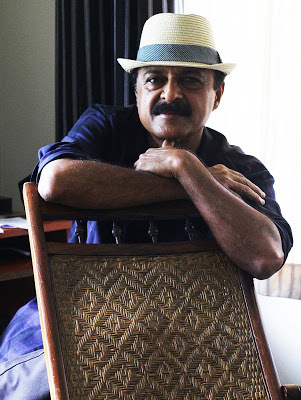 COLUMN: LOCATION DIARY Photo of S. Kumar by Kaviyoor Santhosh (The New Indian Express, Kochi and Thiruvananthapuram)
COLUMN: LOCATION DIARY Photo of S. Kumar by Kaviyoor Santhosh (The New Indian Express, Kochi and Thiruvananthapuram)
Published on June 15, 2016 22:42
June 14, 2016
Travelling The Globe
 Madhu S Nair has travelled to numerous countries over the years. He talks about his experiences and upcoming books on Cuba and Japan
Madhu S Nair has travelled to numerous countries over the years. He talks about his experiences and upcoming books on Cuba and JapanPhoto by Manu R Mavelil
By Shevlin Sebastian
When Madhu S Nair landed at Bogota, Columbia, in 2002, he felt unsure. He did not know Spanish, nor did the people know English. At a terminus, he wanted to take a bus to go to Bolivar Square and see a statue dedicated to South America's most famous revolutionary Simon Bolivar. But he did not know which bus to take.
A teenager, seeing his plight, spoke to him. Somehow, through sign language, and using the words, 'Simon Bolivar', he told her where he wanted to go. She pointed at a bus, at some distance away. So Madhu walked towards it. And got into the bus. Suddenly, he saw the girl running towards him.
Through her gestures, he realised that he had got into the wrong bus. So, he got down, the girl held his hand, and led him to the correct vehicle.
“I was very moved by her concern,” says Madhu. Later, when he wrote a travelogue about his experiences in Colombia, he dedicated the book to this unknown girl.
The Thiruvananthapuram-based Madhu has been an avid traveller for long. In fact, he has gone to over 50 countries in different parts of Europe, America, Asia and Africa. “Travelling broadens the mind,” he says. “You learn to respect different food habits, cultures, creeds and religions. In short, I have learned to respect the human being.”
Asked to give tips for first-time travellers, Madhu says, “You have to be very alert, especially when you go to a country where you don't know the language. It is better to avoid travelling at night. Whereever you go, you should read up about it, so that you can have a sense of history of the place.”
You also have to be prepared for unexpected experiences. Once when Madhu arrived at the port town of Cartagena, in Colombia, there was not a single room available. In the end, he managed to get a room at a brothel. “You need to be fearless at times,” he says, with a laugh.
All these experiences have been grist to his writing. Thus far, he has written 15 books on his various travels, and a few more are in the pipeline. They include books on Cuba, Japan, Tanzania and Vietnam. He is also credited with having written the first book in Malayalam on computers.
Clearly, Madhu has been a man of many parts. After graduation in Metallurgical Engineering, from Kashmir University, in Srinagar, he went to the USA where he did his masters in Technology of Management from the American University at Washington. Thereafter, he worked as a computer specialist at the Goddard Space Flight Centre, belonging to the National Aeronautics Space Administration. Following that, he spent a few years at the Pentagon as a computer scientist.
His conclusions, from his work experience at the Pentagon, are interesting. “In the first few years, you can move upwards steadily,” says Madhu. “But after you reach a certain level, it becomes difficult. Then you will feel you are not a part of the system. You are always regarded as a foreigner.”
So, it was no surprise that Madhu returned to Thiruvananthapuram in 1990. He started the capital's first computer training institute called Krishna Computers. Today, he is the chairman of the India Hospital Trust as well as the Publisher of India Books.
His experiences at the workplace in the US and Kerala have given Madhu a unique perspective. “In the USA, work is like a religion,” says Madhu. “They are serious and dedicated. And they take their vacations seriously, too. Here, there is an apathy towards work. Kerala does not have a business-friendly environment. In America, they place a lot of emphasis on business, especially small firms. Nevertheless, despite its flaws, I have a deep love for my land.”
(The New Indian Express, Kochi and Thiruvananthapuram)
Published on June 14, 2016 22:30



